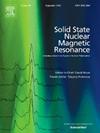用NC、NCC、CNC和CNCC极化转移间接15N检测全细胞甲壳素的固态核磁共振观察
IF 2.4
3区 化学
Q4 CHEMISTRY, PHYSICAL
引用次数: 0
摘要
几丁质是地球上发现的最重要的含氮多糖。这种多糖是一种n -乙酰氨基葡萄糖的聚合物,是真菌细胞壁和甲壳类动物的重要结构成分。魔角旋转固体核磁共振正在成为一种强大的分析方法,在完整细胞壁和整个细胞的背景下研究多糖。甲壳素中乙酰氨基的存在对15N固态核磁共振是有吸引力的。在这里,我们研究了不同的多步极化转移实验,包括在中等旋转频率下间接检测15N,适应于生物固体蛋白质中常用的残基共振分配的脉冲序列。13C,15N几丁质自旋拓扑结构与氨基酸略有不同,我们讨论了使用频率选择性的15N-13C交叉极化转移,然后是宽带或频率选择性的同核13C -13C转移来检测几丁质共振。对于烟曲霉细胞壁中发现的几丁质,通过多步极化转移的间接15N检测可能有利于研究在全细胞和肽聚糖样品中发现的更复杂的含氮多糖。本文章由计算机程序翻译,如有差异,请以英文原文为准。

Solid-state NMR observation of chitin in whole cells by indirect 15N detection with NC, NCC, CNC and CNCC polarization transfers
Chitin is the most important nitrogen-containing polysaccharide found on Earth. This polysaccharide is a polymer of an N-acetylglucosamine and it is a crucial structural component of fungal cell walls and crustaceans. Magic-angle spinning solid-state NMR is emerging as a powerful analytical approach to study polysaccharides in the context of intact cell walls and whole cells. The presence of an acetamido group in chitin is attractive for 15N solid-state NMR. Here we investigate the use of various multi-step polarization transfer experiments incorporating indirect 15N detection at moderate spinning frequency, adapted from pulse sequences commonly employed for residue resonance assignment in biosolid proteins. The 13C,15N chitin spin topology slightly differs from amino acids, and we discussed the use of frequency-selective 15N-13C cross-polarization transfers followed by broadband or frequency-selective homonuclear 13C–13C transfers to detect chitin resonances. Demonstrated here for chitin found in the cell wall of the fungus Aspergillus fumigatus, the use of indirect 15N detection through multi-step polarization transfers could be advantageous to investigate more complex nitrogen-containing polysaccharides found in whole cells and peptidoglycan samples.
求助全文
通过发布文献求助,成功后即可免费获取论文全文。
去求助
来源期刊
CiteScore
5.30
自引率
9.40%
发文量
42
审稿时长
72 days
期刊介绍:
The journal Solid State Nuclear Magnetic Resonance publishes original manuscripts of high scientific quality dealing with all experimental and theoretical aspects of solid state NMR. This includes advances in instrumentation, development of new experimental techniques and methodology, new theoretical insights, new data processing and simulation methods, and original applications of established or novel methods to scientific problems.

 求助内容:
求助内容: 应助结果提醒方式:
应助结果提醒方式:


